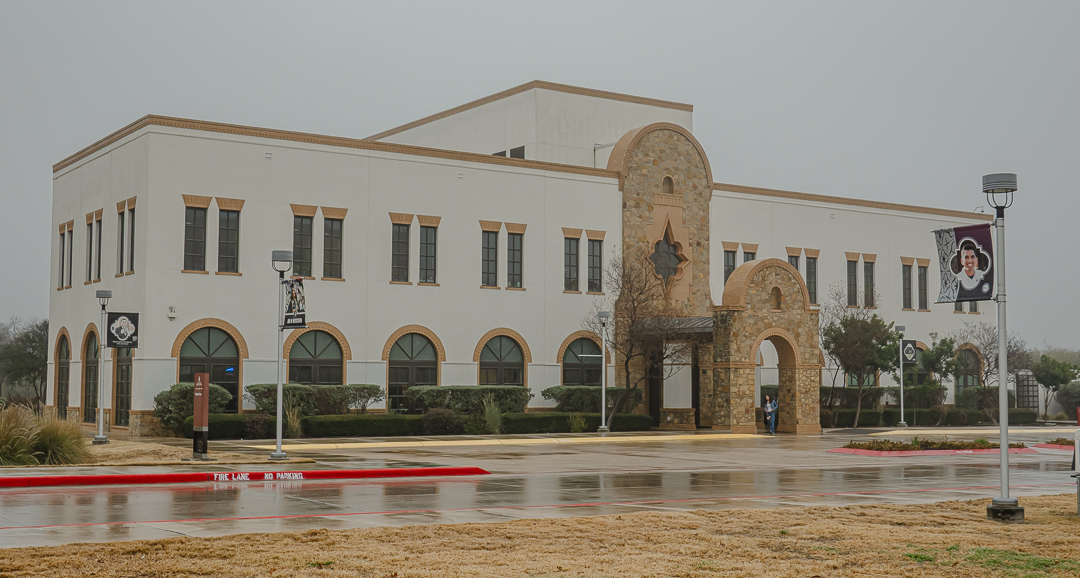This story was updated at 1:08 p.m. March 3 to correct Army Physical Fitness Test to Army Combat Fitness Test and the spelling of First Lt. Ross Baysinger.
Jerome Hamilton, senior cadet at Texas A&M University-San Antonio, joined the Reserved Officers’ Training Corps. in 2021 as a way to pay for college. However, the program led him to gain leadership experience and professional connections.
“I didn’t want to pay for college, so I looked into scholarship opportunities through ROTC,” Hamilton said. “But it turned into something much bigger. I developed leadership skills and built strong connections that will help me beyond my military career.”
Hamilton, an international business management senior set to graduate in spring, 2025, is working toward his goal of becoming a pilot in the U.S. Army. ROTC provided him with leadership training and financial support, which helped him stay on course toward that objective.
TAMUSA’s ROTC program was launched in 2015 at St. Mary’s University and now operates under the University of Texas at San Antonio’s established program. As the university continues to grow, there is potential for ROTC to develop into an independent unit.
First Lt. Ross Baysinger, a cadre member and recruiter for both UTSA and TAMUSA ROTC programs, described how the program is structured.
“UTSA is its own program with a full chain of command up to a lieutenant colonel,” Basinger said. “For TAMUSA, because it is still a growing school, it falls under UTSA’s umbrella for now. But the university is expanding rapidly, and I believe it will eventually become a standalone program.”
What ROTC Offers
ROTC provides students with leadership training, military skills and career preparation while they complete their college degrees. The program emphasizes discipline, teamwork and decision-making under pressure.
According to Maj. Jonathan Caraballo, assistant professor of military science at A&M San Antonio, ROTC prepares students for more than just military service—it builds critical leadership skills that benefit cadets whether they pursue a military career or enter the civilian workforce.
“When you look at ROTC, it’s built around the fundamental aspects of leadership,” Caraballo said. “Many cadets come in fresh out of high school with little workforce experience. Our goal is to instill professionalism, ethics and leadership skills. And with that comes an opportunity to earn a scholarship to help pay for school.”
Eligibility and Enrollment
To contract with the ROTC program, students must meet the following eligibility requirements:
- Be a U.S. citizen between the ages of 17 and 26
- Have a minimum 2.0 GPA and a high school diploma (or equivalent)
- Be accepted to A&M San Antonio
- Pass the Army Combat Fitness Test and meet height/weight standards
- Be medically qualified through the Department of Defense Medical Evaluation Board
- Agree to accept a commission and serve in the U.S. Army, Army Reserve or National Guard
ROTC is structured into two phases:
- Basic Course (First Two Years) – This phase includes elective classes and leadership labs to introduce students to military skills, customs, and leadership principles. Students can take these courses without committing to military service.
- Advanced Course (Final Two Years) – This phase is for contracted cadets who have committed to serving as officers. It includes advanced military tactics, field training and a summer leadership course.
Scholarships and Career Benefits
ROTC offers financial assistance, including scholarships that cover tuition, housing and other expenses.
ROTC scholarships provide:
- Full tuition and fees or room and board coverage
- A book allowance of $1,200 per year
- A monthly stipend ranging from $300 to $500, depending on the cadet’s academic year
For students joining the Texas Army National Guard or Army Reserve, additional Guaranteed Reserve Forces Duty (GRFD) scholarships and federal tuition assistance are available.
Training, Competitions, and Networking
ROTC at TAMUSA involves both classroom instruction and hands-on field training. Cadets participate in leadership labs, tactical exercises and physical fitness training multiple times a week. They also engage in large-scale summer training events, such as Cadet Summer Training (CST) at Fort Knox, where cadets nationwide are assessed on leadership, teamwork and performance under pressure.
Hamilton, who ranked 325th out of 5,000 cadets nationwide at Fort Knox, earned the distinction of Distinguished Military Graduate, an honor awarded to top-performing cadets.
Caraballo described the significance of this ranking.
“Jerome represented the school very well at the national level,” Caraballo said. “Every year, over 5,000 cadets converge at Fort Knox for summer training. This training is where they are assessed and ranked nationally. For a cadet from TAMUSA to place in the top 325 is a huge accomplishment.”
The Ranger Challenge: ROTC’s Varsity Sport
ROTC also offers opportunities for competition and teamwork through events like the Ranger Challenge, which is considered the varsity sport of ROTC. The competition includes obstacle courses, land navigation, physical endurance tests and marksmanship drills.
Hamilton explained the challenge’s significance.
“The best way to describe Ranger Challenge is that it’s like the varsity sport of ROTC,” he said.
“It’s physically demanding and focused on military tasks. We compete against other universities like the University of Houston and Texas A&M-Corpus Christi. It’s not just about fitness—it’s about representing your school at the highest level.”
Extracurricular Activities
In addition to training and competitions, cadets can participate in ROTC-led extracurriculars such as:
- Color Guard – Presenting colors at campus events and local ceremonies
- Bataan Memorial Death March – A 26.2-mile ruck march in honor of WWII soldiers
- Army Ten-Miler – A race in Washington, D.C., promoting fitness and Army pride
Expanding ROTC at A&M San Antonio
The ROTC program is working to expand training opportunities for its cadets. While many exercises currently take place at UTSA or Camp Bullis, efforts are underway to provide more hands-on training on campus, including land navigation drills and tactical exercises behind the gym.
“Next semester, we will host more training events here,” Caraballo said. “We’re planning land navigation, basic tactics and field exercises. We’ve already scouted locations behind the gym to use for training. The goal is to provide more hands-on experience on campus.”
For students considering ROTC, Hamilton encouraged them to visit the program in person.
“Some students hesitate because they don’t fully understand what ROTC offers,” Hamilton said.
“But if they come talk to us, they’ll see that this program is about leadership, career opportunities and personal growth.”
Students interested in learning more about ROTC can visit Student Affairs in Room 212G of Patriots’ Casa or can reach out to Lt. Ross Baysinger at ross.d.baysinger.mil@army.mil.
For more information, visit the official program website at TAMUSA ROTC Jaguar Battalion.






